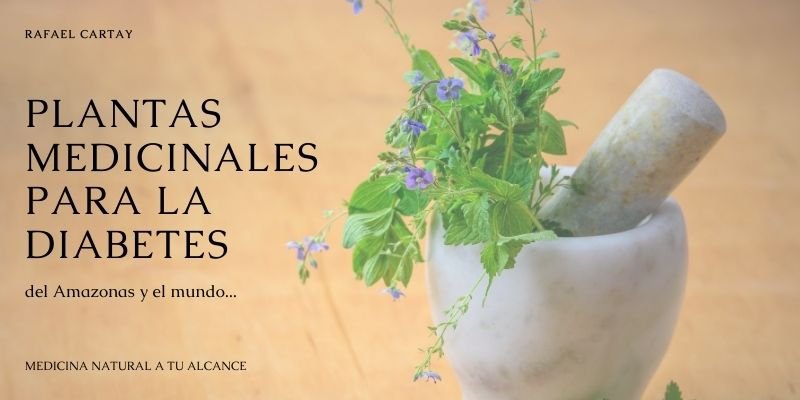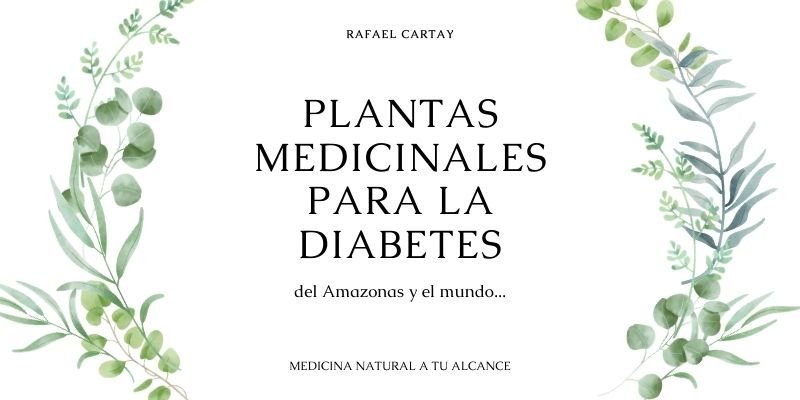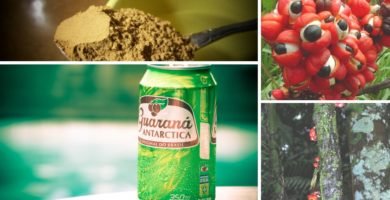
There are many medicinal plants used worldwide to combat diabetes, most of which we know are of Asian origin.
However, in the Amazon we also have a great variety of powerful plants that can help us to treat a diabetic condition.
Medicinal plants for diabetes that will help us to lower blood glucose levels, hypertension, cholesterol, plants with hypoglycemic properties and even those that serve to stimulate insulin production.
How to treat overweight, obesity and diabetes?
There are several ways:
a) that the person changes his or her inconvenient lifestyle;
b) with pharmacological treatment (with drugs such as Orlistat or Naltrexone-bupropion);
c) with invasive surgical treatment (laparascopic stomach reduction surgery, gastric bypass); d) with treatment using appropriate medicinal plants, or phytotherapy, whose safety profile is very broad.
October 5, 2019

Medicinal plants of the Amazon Rainforest
October 5, 2019

Amazon Rainforest Poisonous Plants
October 5, 2019

🥇 Amazon Rainforest Plants: 1001 species, names, photos and uses!
The use of phytotherapy in the treatment of diabetes or its triggers
Phytotherapy has, in this case, four types of plants:
1. Satiating and nutrient absorption-reducing plants;
Among thesatiating and nutrient absorption-reducing plants, the best known are the Asian ones, mainly from China and India:
- glucomannan (Amorphophallus konjac),
- bladderwrack (Fucus vesiculosis ) and
- ispaghale (Plantago ovata).
2. Plants that decrease the absorption of sugars (which combat the resistance to I).
Among those that decrease the absorption of sugars are
- gymnema (Gymnema sylvestre ), from India, tropical Africa and Australia.
3. Plants with thermogenic activity.
Among those with thermogenic activity, the following stand out:
- tea (Camellia sinensis), from China, from whose leaves three types of tea are obtained according to the degree of oxidation (green, black and oolong tea), effective against overweight due to its abundance of polyphenols;
- and guarana (Paullinia cupana), a climbing shrub from the Brazilian Amazon, near the Maués River and its tributaries.
4. Lipogenesis inhibitors and appetite control plants
Among those that inhibit lipogenesis and control appetite is garcinia (Garcinia cambogia), a Southeast Asian shrub.
Most of the known medicinal plants that lower blood glucose levels belong to the ancient folk medicine of China or India, many used in Ayurvedic medicine, such as the Centaura aspera the burdock, the zaragotana, the morphodic, the harpagofito, the ispagula, the galega, etc.

Medicinal plants for diabetes
Is guarana the only plant useful for treating diabetes found in the Amazon basin?
In fact, there are other plants besides guarana that are commonly found throughout the Amazon basin.
- Achiote ( Bixa orellana), whose seeds are used as an antidiabetic;
- Cape gooseberry or aguaymanto (Physalis peruviana), fresh fruits;
- Carob (Hymenaea courbaril), with its bark in decoction;
- Balsamina (Momordica charantia), the whole plant used as a hypoglycemic;
- The cadillo (Bidens pilosa), with the infusion of its leaves;
- The Canelo de monte (Drimys winteri);
- The cow’s hoof or patevaca (Bauhinia variegata), whose leaves and aerial parts are used against diabetes, hypertension and high LDL cholesterol;
- Chaya (Cnidosculus chayamansa), the infusion of its leaves against diabetes;
- Copalchi (Coutarea latifolia), whose macerated bark helps metabolize carbohydrates;
- The chaparro or guayabillo (Curatella americana), whose bark and leaves control diabetes, stimulating the hypoglycemic effect without increasing insulin production;
- The cockroach or miracle leaf (Tradescantia zebrina ), whose leaves in infusion reduce blood glucose levels;
- The stevia(Stevia rebaudiana) whose leaves have a hypoglycemic effect and contain stevioside, which stimulates the beta cells of the pancreas to produce more insulin;
- Eucalyptus (Eucalyptus globulus ), whose leaves in decoction are hypoglycemic;
- Insulin or water creeper (Cissus verticilata ), whose leaves in infusion stimulate the production of insulin;
- The ispágula (Plantago ovata), widespread in the Amazon, whose mucilage reduces serum cholesterol levels;
- Cashew (Anacardium occidentales), whose bark in decoction is hypoglycemic and helps against diabetes;
- Parsley (Petroselinum crispum) whose aerial parts have hypoglycemic activity;
- Rhubarb (Rheum officinale ) whose roots are used to treat diabetes;
- Soy (Glycine max), which lowers LDL cholesterol levels.
What is diabetes?
Overweight, obesity and diabetes are intertwined evils in the medium term.
The human organism runs on energy.
An energy that, according to the first law of thermodynamics, is neither created nor destroyed, but transformed.
The sources of energy for the body are carbohydrates (CH), protein (P) and lipids or fats (L), which provide calories to the body.
When demanding energy (E), the first candidates to cover it are the HCs.
If their quantity and quality is not sufficient, L and P come into action, according to the energetic situation of people’s energy intake and energy expenditure.
Energy intake comes from macronutrients (HC, P and L) and alcohol.
But the bioavailability of food is not 100%, because losses occur mainly in urine and feces.
Total energy expenditure (TEE) is made up of:
a) basal energy expenditure (BEE), expenditure due to the thermogenic effect of food (TEE) and expenditure due to physical exercise of the body (EEE).
EBG accounts for almost 2/3 (60%) of the TSG, and varies according to body composition, sex and weight: it is higher in males and heavier individuals.
GET is the expenditure for internal processing of food in nutrients, and is equivalent to about 10 % of GET: higher in P processing, and then in HC and L.
The GEF is equivalent to about 30% of the GET, as a consequence of programmed physical exercise and spontaneous physical activities.
The relationship between energy intake and expenditure depends on the appearance on the scene of that undesirable trio: overweight, obesity and diabetes.
Must be given:
1) an imbalance between intake and expenditure;
2) genetic deficit of the weight control system, and
3) of both. Overweight heralds obesity, and obesity is related to the metabolic syndrome, which corresponds to risk factors for cardiovascular disease and the onset of type 2 diabetes (hyperglycemia, hypertriglyceridemia, low levels of HDL cholesterol and high levels of LDL cholesterol in the blood, hypertension and central obesity) and insulin resistance (I).
Each time one ingests food, glycemia increases, and the concentration of Ia I in the blood.
I is a hormone that replenishes energy reserves. L accumulate in the adipocytes of adipose tissue, which change their diameter and volume to accommodate triglycerides as an energy reserve.
But the same is not true for L and P, with limited capacity to reserve energy.
Hypertrophied adipose tissue does not respond to the antilipid signals of I. And resistance to I is produced by an excess of free fatty acids at the plasma level.
And that torrent of free fatty acids reaches the liver. If this is prolonged over time, the person suffers cardiovascular complications such as acute myocardial infarction.

Source: Manu5 / CC BY-SA
Basic references
- Colombia. Ministry of Social Protection. 2008. Colombian Vademecum of Medicinal Plants. Bogotá: Ministry of Social Protection- National University of Colombia.
- Chirif, A. 2016. Amazon Dictionary. Castilian voices in the Peruvian jungle. Lima: Rain Publishers- CAAAP.
- Fernández-González B. 2016. Phytotherapeutic treatment of overweight and obesity. Thesis. Faculty of Pharmacy. Complutense University.
- Figueroa-Valverde L. Díaz-Cedillo F., Camacho-Luis A., López M.R. 2009. Effects induced by Ruta graveolens L, Cnidoscolus chayamansa McVaugh, and Citrus aurantium L, on glucose, cholesterol, and triacylglyceride levels in a diabetic rat model. Braz. J. Pharmacog. 19 (4), 898-907.
- Navarro M.C., ortega T. 2009. Medicinal plants for overweight. Madrid: INFITO-Editorial Complutense.
- Rodríguez U., Sheila L., Elika M. 2007. Effects of Physalis peruviana (aguaymanto) intake on postprandial glycemia in young adults. Rev. Vallejiana Physician, 4 (1), 4-53.
- Seron V.D., Furlan M.M. 2010. Role of green tea and its components in the treatment of type 2 diabetes mellitus. Rev. Health and Research, 3 (3), 379-383.
- Valenzuela-Soto R., Morales-Rubio M.E., Verde-Star M.J., Oranday-Cárdenas A., Preciado-Rangel P., González J.A., Esparza-Rivera J.R. 2015. Organic hydroponic hydroponic Cnidoscolus chayamansa and its hypoglycemic capacity, nutraceutical quality and toxicity. Rev. Mex. Sci. Agric. Vol. 6 (4), May-June.

Dr. Rafael Cartay is a Venezuelan economist, historian, and writer best known for his extensive work in gastronomy, and has received the National Nutrition Award, Gourmand World Cookbook Award, Best Kitchen Dictionary, and The Great Gold Fork. He began his research on the Amazon in 2014 and lived in Iquitos during 2015, where he wrote The Peruvian Amazon Table (2016), the Dictionary of Food and Cuisine of the Amazon Basin (2020), and the online portal delAmazonas.com, of which he is co-founder and main writer. Books by Rafael Cartay can be found on Amazon.com
This post is also available in:
![]() Español (Spanish)
Español (Spanish)


